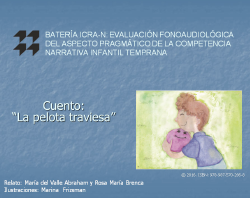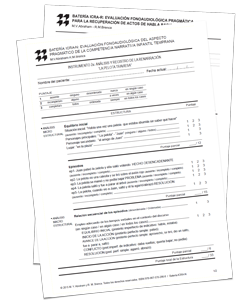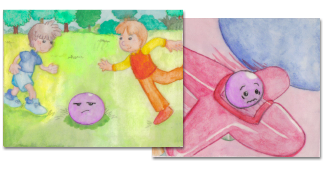

Development of early narrative skills
Instrument 2.a – Renarration
Analysis and record of the renarration of “La pelota traviesa”
“A speech macro-act is a speech act resulting from a sequence of speech acts linearly connected. A tale is a good example of this.” (Teun van Dijk)

A child’s capacity to understand and produce speech implies the command of complex linguistic and cognitive skills, such as sequence of events, creation of a cohesive text by using explicit linguistic markers, use of precise vocabulary, transmission of ideas without extra linguistic support, comprehension of cause-effect relationships, and organization of a narration according to the lines of the universal scheme of story-telling, that helps the listener understand the story (Paul, R. et al., 1996; Pavez, M., 1999; Bates, E. and MacWhinney, B., 1979; Liles, B., 1993; Wells, G., 1986).
These skills show that narrative is a privileged example of language and evidence the need to have specific resources to assess and approach early narrative skills in speech and language therapeutically.
Instrument 2.a – Renarration
Characteristics of Instrument 2.A

Instrument 2.A assesses quantitatively and qualitatively the child’s basic competence to re-narrate. It consists of 22 items with different response categories, organized at two levels:Structure (micro and macro) and Content (cohesion and coherence, morphological and syntactic organization and referentiality).
Materiales
•“The Lively ball” (“La pelota traviesa”)(text, illustrations and audio)
This is a tale written ad hoc (text and illustrations). Audiovisual format. Characteristics:
- Linguistic and aesthetic style, and topic accessible to preschool children.
- Colored images focusing on significant components of each episode.
Instrument 2.a – Renarration
- Text of canonical structure including introduction, body and ending. It is composed of cohesive relationships (temporal, spatial, causal and lexical), with no complications that interfere unnecessarily with the child’s discourse recovery.
- Episode design: It has 5 episodes; it follows the criteria of Story Grammar (Stein, 1979).
After having seen and listened “La pelota traviesa” in an audiovisual format, the child is invited to tell the story without visual support. All that has been re-narrated by him is analyzed by applying Instrument 2.a and focusing on two axes: STRUCTURE (macro and micro-structural levels) and CONTENT (cohesion and coherence).

• Guide for identifying and analyzing the episodes of “La pelota traviesa”.
This guide is part of Instrument 2.a. It was designed to analyze episodes within the micro-structural record of the child’s re-narration. It guides the speech and language pathologist to record the minimum components of each episode and, from this, to establish the corresponding response categories: absent, incomplete, complete.